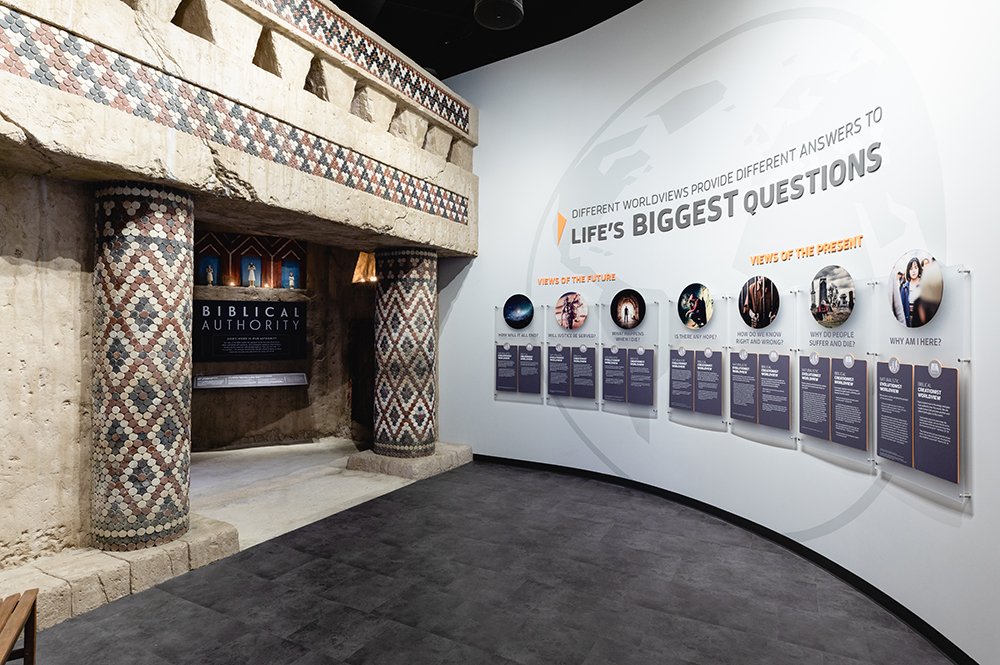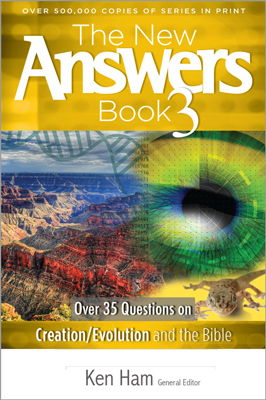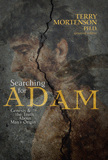
Chapter 8
Did Bible Authors Believe in a Literal Genesis?
How Old and New Testament authors, Jesus, and we should understand the genre of Genesis 1–11, and why it’s vital to a proper biblical hermeneutic.
How should we interpret Genesis 1–11?
Anyone who has read the Bible very much will recognize that there are different kinds of literature in the Old and New Testaments. There are parables, poetry, prophetic visions, dreams, epistles, proverbs, and historical narrative, with the majority being the latter. So, how should we interpret Genesis 1–11? Is it history? Is it mythology? Is it symbolic poetry? Is it allegory? Is it a parable? Is it a prophetic vision? Is it a mixture of these kinds of literature or some kind of unique genre? And does it really matter anyway?
We will come back to the last question later, but suffice it to say here that the correct conclusion on genre of literature is foundational to the question of the correct interpretation. If we interpret something literally that the author intended to be understood figuratively, then we will misunderstand the text. When Jesus said, “I am the door
” (John 10:9), He did not mean that He was made of wood with hinges attached to His side. Conversely, if we interpret something figuratively that the author intended to be taken literally, we will err. When Jesus said, “The Son of Man is about to be betrayed into the hands of men, and they will kill Him, and the third day He will be raised up
” (Matthew 17:22–23), He clearly meant it just as literally as if I said to my wife, “Margie, I’m going to fill up the gas tank with gas and will be back in a few minutes.”
There are many lines of evidence we could consider to determine the genre of Genesis 1–11, such as the internal evidence within the Book of Genesis and how the Church has viewed these chapters throughout church history. But in this chapter we want to answer the question, “How did the other biblical authors (besides Moses, who wrote Genesis1) and Jesus interpret them?” From my reading and experience it appears that most people who consider the question of how to interpret the early chapters of Genesis have never asked, much less answered, that question.

The Bible is scientifically and historically accurate in its claims. We can derive the earth’s age based on the biblical record, as depicted in this exhibit at the Creation Museum.
To begin, consider what God says about the way He spoke to Moses in contrast to the way He spoke to other prophets. In Numbers 12:6–8 we read:
Then He said, “Hear now My words: if there is a prophet among you, I, the Lord, make Myself known to him in a vision; I speak to him in a dream. Not so with My servant Moses; he is faithful in all My house. I speak with him face to face, even plainly, and not in dark sayings; And he sees the form of the Lord. Why then were you not afraid to speak against My servant Moses?”
So God says that He spoke “plainly
” to Moses, not in “dark sayings
,” that is, not in obscure language. That strongly suggests that we should not be looking for mysterious, hard-to-understand meanings in what Moses wrote. Rather, we should read Genesis as the straightforward history that it appears to be. An examination of how the rest of the Bible interprets Genesis confirms this.
Old Testament Authors and Their Use of Genesis
When we turn to other Old Testament authors, there are only a few references to Genesis 1–11. But they all treat those chapters as literal history.
The Jews were very careful about genealogies. For example, in Nehemiah 7:61–64 the people who wanted to serve in the rebuilt temple needed to prove that they were descended from the priestly line of Aaron. Those who could not prove this could not serve as priests. First Chronicles 1–8 gives a long series of genealogies all the way back to Adam. Chapter 1 (verses 1–28) has no missing or added names in the genealogical links from Adam to Abraham, compared to Genesis 5 and Genesis 11. The author(s) of 1 Chronicles obviously took these genealogies as historically accurate.
Outside of Genesis 6–11, Psalm 29:10 contains the only other use of the Hebrew word mabbul (translated “flood
”).2 God literally sat as King at the global Flood of Noah. If that event was not historical, the statement in this verse would have no real force and the promise of verse 11 will give little comfort to God’s people.
Psalm 33:6–9 affirms that God created supernaturally by His Word, just as Genesis 1 says repeatedly. Creatures came into existence instantly when God said, “Let there be. . . .
” God did not have to wait for millions or thousands of years for light or dry land or plants and animals or Adam to appear. “He spoke and it was done; He commanded and it stood fast
” (Psalm 33:9).
Psalm 104:5 and 19 speak of events during creation week.3 But verses 6–9 in this psalm give additional information to that provided in Genesis 8, which describes how the waters receded off the earth at the end of the Flood.4 The Psalmist is clearly describing historical events.
In beautiful poetic form, Psalm 136 recounts many of God’s mighty acts in history, beginning with statements about some of His creative works in Genesis 1.
In Isaiah 54:9 God says (echoing the promise of Psalm 104:9) to Israel, “For this is like the waters of Noah to Me; for as I have sworn that the waters of Noah would no longer cover the earth, so have I sworn that I would not be angry with you, nor rebuke you.
” The promise of God would have no force if the account of Noah’s Flood was not historically true. No one would believe in the Second Coming of Christ if the promise of it (as recorded in Matt. 24:37–39) was given as, “Just as Santa Claus comes from the North Pole in his sleigh pulled by reindeer on Christmas Eve and puts presents for the whole family under the Christmas tree in each home, so Jesus is coming again as the King of kings and Lord of lords.” In fact, the analogy would convince people that the Second Coming is a myth.

The archaeological record confirms the history recorded in the Bible, as explained at the Creation Museum.
In Ezekiel 14:14–20 God refers repeatedly to Noah, Daniel, and Job and clearly indicates that they were all equally historical and righteous men. There is no reason to doubt that God meant that everything the Bible says about these men is historically accurate.
New Testament Authors’ View of Genesis
The New Testament has many more explicit references to the early chapters of Genesis.
The genealogies of Jesus presented in Matthew 1:1–17 and Luke 3:23–38 show that Genesis 1–11 is historical narrative. These genealogies must all be equally historical or else we must conclude that Jesus was descended from a myth and therefore He would not have been a real human being and therefore not our Savior and Lord.5
Paul built his doctrine of sin and salvation on the fact that sin and death entered the world through Adam. Jesus, as the Last Adam, came into the world to bring righteousness and life to people and to undo the damaging work of the first Adam (Romans 5:12–19; 1 Corinthians 15:21–22, 45–47). Paul affirmed that the serpent deceived Eve, not Adam (2 Corinthians 11:3; 1 Timothy 2:13–14). He took Genesis 1–2 literally by affirming that Adam was created first and Eve was made from the body of Adam (1 Corinthians 11:8–9). In Romans 1:20, Paul indicated that people have seen the evidence of God’s existence and some of His attributes since the creation of the world.6 This means that Paul believed that man was right there at the beginning of history, not billions of years after the beginning.
Peter similarly based some of his teachings on the literal history of Genesis 1–11. In 1 Peter 3:20, 2 Peter 2:4–9, and 2 Peter 3:3–7, he referred to the Flood. He considered the account of Noah and the Flood just as historical as the account of the judgment of Sodom and Gomorrah (Genesis 19). He affirmed that only eight people were saved and that the Flood was global, just as the future judgment at the Second Coming of Christ will be. He argued that scoffers will deny the Second Coming because they deny the supernatural creation and Noah’s Flood. And Peter told his readers that scoffers will do this because they are reasoning on the basis of the philosophical assumption that today we call uniformitarian naturalism: “all things continue as they were from the beginning of creation
” (2 Peter 3:4).7
It has been objected that the apostles did not know the difference between truth and myth. But this is also false. In 1 Corinthians 10:1–11 Paul refers to a number of passages from the Pentateuch where miracles are described and he emphasizes in verses 6 and 11 that “these things happened
.” In 2 Timothy 4:3–4 Paul wrote:
For the time will come when they will not endure sound doctrine, but according to their own desires, because they have itching ears, they will heap up for themselves teachers; and they will turn their ears away from the truth, and be turned aside to fables.
The Greek word translated here as “fables
” is muthos, from which we get our English word “myth.” In contrast to “truth
” or “sound doctrine
,” the same Greek word is used in 1 Timothy 1:4, 4:7; Titus 1:14; and 2 Peter 1:16. In a first-century world filled with Greek, Roman, and Jewish myths, the apostles clearly knew the difference between truth and myth. And they constantly affirmed that the Word of God contains truth, not myth.
Christ and His Use of Genesis
The Bible is faithful, reliable, and truthful. The Scriptures cannot be contradicted or confounded.
In John 10:34–35 Jesus defended His claim to deity by quoting from Psalm 82:6 and then asserting that “Scripture cannot be broken.
” That is, the Bible is faithful, reliable, and truthful. The Scriptures cannot be contradicted or confounded. In Luke 24:25–27 Jesus rebuked His disciples for not believing all that the prophets have spoken (which He equates with “all the Scriptures
”). So in Jesus’s view, all Scripture is trustworthy and should be believed.
Another way that Jesus revealed His complete trust in the Scriptures was by treating as historical fact the accounts in the Old Testament, which most contemporary people think are unbelievable mythology. These historical accounts include Adam and Eve as the first married couple (Matthew 19:3–6, Mark 10:3–9), Abel as the first prophet who was martyred (Luke 11:50–51), Noah and the Flood (Matthew 24:38–39), the experiences of Lot and his wife (Luke 17:28–32), the judgment of Sodom and Gomorrah (Matthew 10:15), Moses and the serpent in the wilderness wanderings after the exodus from Egypt (John 3:14), Moses and the manna from heaven (John 6:32–33, 49), the miracles of Elijah (Luke 4:25– 27), and Jonah in the big fish (Matthew 12:40–41). As Wenham has compellingly argued,8 Jesus did not allegorize these accounts but took them as straightforward history, describing events that actually happened, just as the Old Testament describes. Jesus used these accounts to teach His disciples that the events of His own death, resurrection, and Second Coming would likewise certainly happen in time-space reality. Jesus also indicated that the Scriptures are essentially perspicuous (or clear): 11 times the gospel writers record Him saying, “Have you not read . . . ?
”9 And 30 times He defended His teaching by saying, “It is written.
”10 He rebuked His listeners for not understanding and believing what the text plainly says.

The Creation Museum affirms the Bible’s authority and truth from the very first verse.
Besides the above-mentioned evidence that Jesus took Genesis 1–11 as straightforward, reliable history, the gospel writers record three important statements that reveal Jesus’ worldview. Careful analysis of these verses (Mark 10:6; Mark 13:19–20; Luke 11:50–51) shows that Jesus believed that Adam and Eve were in existence essentially at the same time that God created everything else (and Abel was very close to that time), not millions or billions of years after God made the other things.11 This shows that Jesus took the creation days as literal 24-hour days. So everything Jesus said shows that we can justifiably call Him a young-earth creationist.
It has been objected that in these statements Jesus was just accommodating the cultural beliefs of His day. But this is false for four reasons. First, Jesus was the truth (John 14:6), and therefore He always spoke the truth. No deceitful or misleading words ever came from His mouth (1 Peter 2:22). Even his enemies said, “Teacher, we know that You are truthful and defer to no one; for You are not partial to any, but teach the way of God in truth
” (Mark 12:14; NASB). Second, Jesus taught with authority on the basis of God’s Word, which He called “truth
” (John 17:17), not as the scribes and Pharisees taught based on their traditions (Matthew 7:28–29). Third, Jesus repeatedly and boldly confronted all kinds of wrong thinking and behavior in his listeners’ lives, in spite of the threat of persecution for doing so (Matthew 22:29; John 2:15–16, 3:10, 4:3–4, 9; Mark 7:9–13). And finally, Jesus emphasized the foundational importance of believing what Moses wrote in a straightforward way (John 5:45; Luke 16:31, 24:25–27, 24:44–45; John 3:12, Matthew 17:5).
Why Is This Important?
We should take Genesis 1–11 as straightforward, accurate, literal history because Jesus, the Apostles, and all the other biblical writers did so. There is absolutely no biblical basis for taking these chapters as any kind of non-literal, figurative genre of literature. That should be reason enough for us to interpret Genesis 1–11 in the same literal way. But there are some other important reasons to do so.
Only a literal, historical approach to Genesis 1–11 gives a proper foundation for the gospel and the future hope of the gospel. Jesus came into the world to solve the problem of sin that started in real, time-space history in the real Garden of Eden with two real people called Adam and Eve and a real serpent that spoke to Eve.12 The sin of Adam and Eve resulted in spiritual and physical death for them, but also a divine curse on all of the once “very good
” creation (see Genesis 1:31 and 3:14–19). Jesus is coming again to liberate all Christians and the creation itself from that bondage to corruption (Romans 8:18–25). Then there will be a new heaven and a new earth, where righteousness dwells and where sin, death, and natural evils will be no more. A non-literal reading of Genesis destroys this message of the Bible and ultimately is an assault on the character of God.13
Genesis is also foundational to many other important doctrines in the rest of the Bible, such as male, loving headship in the home and the church.
Conclusion
The Bible is crystal clear. We must believe Genesis 1–11 as literal history because Jesus, the New Testament Apostles, and the Old Testament prophets did, and because these opening chapters of Genesis are foundational to the rest of the Bible.
As we and many other creationists have always said, a person doesn’t have to believe that Genesis 1–11 is literally true to be saved. We are saved when we repent of our sins and trust solely in the death and Resurrection of Jesus Christ for our salvation (John 3:16; Romans 10:9–10). But if we trust in Christ and yet disbelieve Genesis 1–11, we are being inconsistent and are not faithful followers of our Lord.
God said through the prophet Isaiah (see Isaiah 66:1–2):
Thus says the Lord: “Heaven is My throne, and earth is My footstool. Where is the house that you will build Me? And where is the place of My rest? For all those things My hand has made, and all those things exist, says the Lord. But on this one will I look: on him who is poor and of a contrite spirit, and who trembles at My word.”
Will you be one who trembles at the words of God, rather than believing the fallible and erroneous words of evolutionists who develop hypotheses and myths that deny God’s Word? Ultimately, this question of the proper interpretation of Genesis 1–11 is a question of the authority of God’s Word.
The New Answers Book 3
Do you have answers to the big questions about the Christian faith, evolution, creation, and the biblical worldview?
Read Online Buy BookFootnotes
- That Moses was the author of the first five books (called the Pentateuch) of the Old Testament is clear from Scripture itself. The Pentateuch explicitly claims this in Exodus 17:14, 24:4, 34:27; Numbers 33:1–2; Deuteronomy 31:9–11. Other OT books affirm that Moses wrote these books, which by the time of Joshua became known collectively as “the Law,” “the book of the Law,” or “the Law of Moses”: Joshua 1:8, 8:31–32; 1 Kings 2:3; 2 Kings 14:6 (quoting Deuteronomy 24:16), 2 Kings 21:8; Ezra 6:18; Nehemiah 13:1; Daniel 9:11–13; Malachi 4:4. The New Testament agrees in Matthew 19:8; John 5:46–47, 7:19; Acts 3:22 (quoting from Deuteronomy 18:15); Romans 10:5 (quoting from Leviticus 18:5), and Mark 12:26 (referring to Exodus 3:6). Jewish tradition also ascribes the Pentateuch to Moses. Also, the theories of liberal theologians who deny the Mosaic authorship of these books are fraught with false assumptions and illogical reasoning. See Gleason L. Archer Jr., A Survey of Old Testament Introduction (Chicago, IL: Moody Press, 1985), p. 109–113.
- There are four other Hebrew words that are used in the OT to describe lesser, localized floods.
- Most of this psalm is referring to aspects of God’s creation as it existed at the time the Psalmist was writing. Contrary to what some old-earth creationists assert, Psalm 104 is not a “creation account.”
- That these verses do not refer to creation week is evident from the promise reflected in verse 9, which echoes the promise of Genesis 9:11–17. God made no such promise on the third day of creation week when He made dry land appear.
- In Matthew 1:1–17, Matthew has clearly left out some names in his genealogy (for a literary purpose), as seen by comparing it to the Old Testament history. But all the people are equally historical all the way back to Abraham, who is first mentioned in Genesis 11. Luke 3:23–38 traces the lineage of Jesus back to Adam. There is no reason to think there are any missing names in Luke’s genealogy, because 1) he was concerned about giving us the exact truth (Luke 1:4), and 2) his genealogy from Adam to Abraham matches 1 Chronicles 1:1–28 and Genesis 5 and 11, and there is no good reason for concluding that Genesis has missing names. See Ken Ham and Larry Pierce, “Who Begat Whom? Closing the Gap in Genesis Genealogies,” www.answersingenesis.org/articles/am/v1/n2/who-begat-whom, and Travis R. Freeman, “Do the Genesis 5 and 11 Genealogies Contain Gaps?” in Terry Mortenson and Thane H. Ury, eds., Coming to Grips with Genesis (Green Forest, AR: Master Books, 2008), p. 283–314.
- The New King James and the King James Version translate the Greek in this verse as “from the creation of the world.” The word “from” in English has a similar range of meanings as the Greek word (apo) that it translates here. There are a number of reasons to take it in a temporal sense, meaning “since” as the NAS, NIV, and ESV translate it. For a fuller discussion of this important verse, see Ron Minton, “Apostolic Witness to Genesis Creation and the Flood,” in Terry Mortenson and Thane H. Ury, eds., Coming to Grips with Genesis (Green Forest, AR: Master Books, 2008), p. 351–354.
- For more discussion of this, see Terry Mortenson, “Philosophical Naturalism and the Age of the Earth: Are They Related?” The Master’s Seminary Journal 15 no. 1 (2004): 71–92, online at https://answersingenesis.org/age-of-the-earth/are-philosophical-naturalism-and-age-of-the-earth-related/.
- John Wenham, Christ and the Bible (Downers Grove, IL: InterVarsity Press, 1973), p. 11–37.
- In these instances Jesus referred to Genesis 1–2, Exodus 3–6, 1 Samuel 21:6, Psalm 8:2 and 118:22, and to unspecified Levitical law—in other words, to passages from the historical narrative, the Law, and the poetry of Scripture.
- Passages He specifically cited were from all five books of the Pentateuch, Psalms, Isaiah, Jeremiah, Zechariah, and Malachi. Interestingly, in the temptation of Jesus, Satan used Scripture literally and, in response, Jesus did not imply that the literal interpretation of Satan was wrong. Rather, He corrected Satan’s misapplication of the text’s literal meaning by quoting another text, which He took literally (see Matthew 4:6–7).
- See Terry Mortenson, “Jesus’ View of the Age of the Earth,” in Terry Mortenson and Thane H. Ury, eds., Coming to Grips with Genesis (Green Forest, AR: Master Books, 2008), p. 315–346.
- Why Christians have trouble believing Genesis 3 when it speaks of a talking serpent is a mystery to me. We have talking parrots today, which involves no miracles. And if the Christian believes in any miracles of the Bible, then he must believe that Balaam’s donkey was used by God to speak to the false prophet (Numbers 22:28). Since Satan is a supernatural being who can do supernatural things (e.g., 2 Corinthians 11:11–13; Matthew 4:1–11; 2 Thessalonians 2:8–9), it is not difficult at all to understand or believe that he could speak through a serpent to deceive Eve (cf. 2 Corinthians 11:3; Revelation 12:9).
- See James Stambaugh, “Whence Cometh Death? A Biblical Theology of Physical Death and Natural Evil,” and Thane H. Ury, “Luther, Calvin, and Wesley on the Genesis of Natural Evil: Recovering Lost Rubrics for Defending a Very Good Creation,” in Terry Mortenson and Thane H. Ury, eds., Coming to Grips with Genesis (Green Forest, AR: Master Books, 2008), p. 373–398 and 399–424, respectively.
Recommended Resources

Answers in Genesis is an apologetics ministry, dedicated to helping Christians defend their faith and proclaim the good news of Jesus Christ.
- Customer Service 800.778.3390
- Available Monday–Friday | 9 AM–5 PM ET
- © 2025 Answers in Genesis




